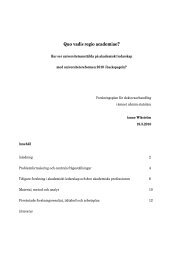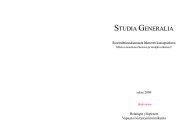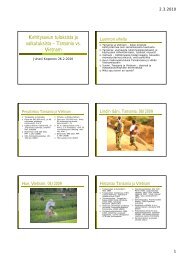the case of the 'urban villas'
the case of the 'urban villas'
the case of the 'urban villas'
You also want an ePaper? Increase the reach of your titles
YUMPU automatically turns print PDFs into web optimized ePapers that Google loves.
Evan Proudfoot<br />
PRS (Probationary Research Student) in Archaeology<br />
Lincoln College, University <strong>of</strong> Oxford<br />
Non Item Valvata: The Seasonality <strong>of</strong> Physical Boundaries in <strong>the</strong> Pompeian Domus<br />
Seasonality was an important consideration in <strong>the</strong> layout <strong>of</strong> rooms and <strong>the</strong> design <strong>of</strong> <strong>the</strong>ir<br />
closures (i.e. doors and windows) in antiquity. Vitruvius (De Architectura, VI.4.1-2)<br />
observed that rooms should be orientated based upon <strong>the</strong>ir daily functions and seasonal use,<br />
and modern scholars have sought confirmation <strong>of</strong> <strong>the</strong>se principles in <strong>the</strong> (groundfloor) layout<br />
<strong>of</strong> houses at <strong>the</strong> Vesuvian sites. Yet <strong>the</strong> spatial and organizational constraints on an urban<br />
domus with a long architectural history must have necessitated <strong>the</strong> adaptive use <strong>of</strong> rooms in<br />
<strong>the</strong>se houses throughout <strong>the</strong> year, and so specific examples <strong>of</strong> seasonal orientation are seldom<br />
identifiable.<br />
Given such constraints, how did ancient inhabitants adapt pre-existing and newly built<br />
rooms to take advantage <strong>of</strong> seasonal changes in light, temperature, display, and social<br />
function? Varro (De Lingua Latina, VIII.29) gives one indication when he states that “we do<br />
not install <strong>the</strong> same types <strong>of</strong> doors and windows in our winter and summer triclinia.” An all-<br />
too-narrow assumption has been that Varro refers to solid-panel doors <strong>of</strong> varying widths.<br />
Likewise, scholars have tended to regard wide reception rooms as closed mainly by curtains,<br />
or fully exposed, bounded by ‘visually arresting’ mosaic thresholds. But <strong>the</strong> internal<br />
boundaries <strong>of</strong> <strong>the</strong> Roman domus were not merely symbolically demarcated, <strong>the</strong>y were<br />
physically constituted.<br />
Drawing upon newly compiled evidence, <strong>the</strong> results <strong>of</strong> a comprehensive ‘threshold<br />
research project,’ this paper will examine <strong>the</strong> fascinating variety <strong>of</strong> closures used in<br />
Pompeian houses. From <strong>the</strong> widespread existence <strong>of</strong> secondary fauces entrance doors, to<br />
folding valvae, wheeled latticework screens, track-guided sliding doors, and fully glazed<br />
peristyles and triclinia, it will seek to understand <strong>the</strong> domus as <strong>the</strong> dynamic, seasonal<br />
environment it must have been, while negotiating <strong>the</strong> ever-present boundaries between public<br />
and private.

















